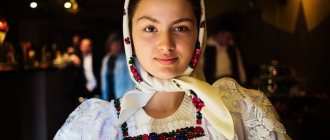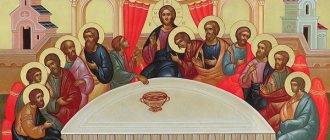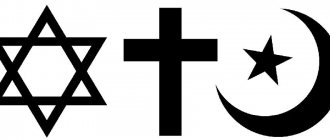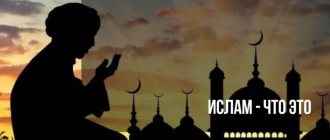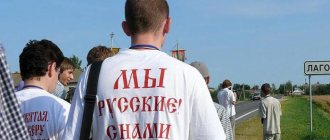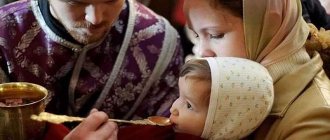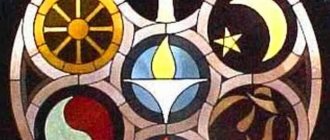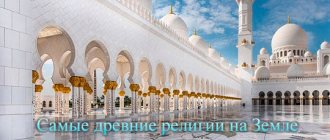Russia is a huge state that unites many nations with one word “Russians”. However, this does not prevent each nation from having its own religious traditions and customs. Many foreigners are surprised and delighted by how our country treats the issue of religion. In Russia, no religious movement can assume dominant status, since at the legislative level the country is recognized as a secular state. Therefore, peoples can choose for themselves the faith they want, and no one will persecute them for it. But still, what religions exist in Russia? Are there really so many different movements in the country that peacefully coexist with each other? We will try to answer these and other questions in the article.
Let's consider the topic through the prism of the law
Freedom of religion in Russia is constitutionally enshrined. Citizens decide for themselves what exactly to believe in and which churches to visit. You can also always remain an atheist and not support any of the faiths. And there are a lot of them on the territory of the country: according to the latest data, seventy religious denominations have been identified that are actively operating in the state. Based on this, we can safely conclude that the issue of religion in Russia is not a pressing issue. Believers respect each other's rights and freedoms without encroaching on alien religious traditions.
At the legislative level, there is a ban on insulting the feelings of believers and committing actions that can be interpreted as disrespect for them. Criminal penalties are provided for such acts.
This attitude towards religion ensures the inviolability and immutability of freedom of religion in Russia. Many scientists believe that this is historically predetermined. After all, our country has always been a multinational state where conflicts based on religious hatred have never arisen. All nations and peoples have respected each other's rights and beliefs for many centuries. This situation continues to this day.
However, many are interested in what religion in Russia can be considered the most important? Let's look for the answer to this question together in the following sections of the article.
Religion is a form of culture
We found out that religion sets norms of behavior, regulates people's relationships, and even fills life with meaning (lucky are those who did not have it). In the process of development, religious customs were closely intertwined with the cultural traditions of different peoples. So close that they can no longer be separated.
For example, the Christian custom of baking pancakes and burning a straw doll on Maslenitsa is rooted in paganism, the worship of the sun god Yarilo. An endless number of such examples can be given. Therefore, scientists consider religion as one of the forms of culture, the result of human activity.
Religious composition of the population of Russia
Types of religion in Russia are not difficult to determine. This can be done approximately by every resident of the country who has a sufficient number of friends and acquaintances. Most likely, among them there will be Christians, Buddhists and even adherents of Islam. However, these are not all religions represented in the state. In fact, each of them has branches and a few religious associations. Therefore, in reality, the religious “carpet” looks much more colorful.
If we rely on official statistics, then the main religion in Russia can be called Christianity. It is noteworthy that most of the population adheres to it. But at the same time, religion is represented by all the main branches:
- Orthodoxy;
- Catholicism;
- Protestantism.
What religion in Russia can be placed in second place in terms of prevalence? Oddly enough for many, this religion is Islam. It is confessed mainly in the south of our country.
The third and subsequent places are occupied by Buddhism, Taoism, Judaism and other religious movements. In the next section we will talk in more detail about the religion of the peoples of Russia.
Islam and Judaism are among the traditional religions of Russia
Islam and Judaism are included in the list of traditional religions of Russia. According to expert data, there are approximately 8,000,000 Muslims in Russia.
8 million
there are so many Muslims in Russia, the vast majority of them are Tatars
At the same time, according to the Spiritual Administration of Muslims of the European Part of the Russian Federation, about 20 million Muslims live in Russia. The vast majority of Russian Muslims are Russian Tatars.
The oldest Derbent Juma mosque of the 8th century. Islam disputes the primacy in Russia in terms of the number of parishioners with Orthodoxy. Photo: upload.wikimedia.org
Among them, the majority are so-called “ethnic” Muslims who do not comply with the requirements of the Muslim faith and consider themselves to be Islam due to tradition or place of residence (there are especially many of these in Tatarstan and Bashkortostan).
The communities in the Caucasus (excluding the Christian region of North Ossetia) are stronger.
The majority of Muslims live in the Volga-Ural region, as well as in the North Caucasus, Moscow, St. Petersburg and Western Siberia.
In 1993, the Spiritual Administration of Muslims of the European Part of Russia was created. Muslims of the North Caucasus created their own coordination center.
Russian Tatars form the northernmost Muslim community in Europe.
The number of Jews in Russia is about 1.5 million. Of these, according to the Federation of Jewish Communities of Russia (FEOR), about 500 thousand people live in Moscow, and about 170 thousand live in St. Petersburg. There are about 70 synagogues in Russia.
Along with FEOR, another large association of religious Jewish communities is the Congress of Jewish Religious Organizations and Associations in Russia. According to the 2002 census, the official number of Jews in Russia is 233,439 people.
Statistical data
To find out about religion in Russia in percentage, you need to turn to official sources. However, there is some tension with them in the country. The fact is that thanks to freedom of religion, the state does not control the number of believers. It cannot provide accurate data on the confessions and religious self-identification of citizens. Therefore, it is possible to extract any useful information only from sociological surveys of the population, and it is difficult to vouch for their reliability. Moreover, most of the data from sociologists is quite contradictory and only after a thorough comparative analysis can any conclusions be drawn.
If we focus on the latest data from the Russian Academy of Sciences (2012-2013), then in percentage terms the religious picture looks like this:
- Seventy-nine percent of respondents consider themselves Orthodox;
- Muslims – four percent of Russians;
- no more than one percent of the country’s citizens identified themselves with other religious movements;
- Nine percent of respondents did not identify themselves with any religion;
- Seven percent of the population called themselves atheists.
And here is what the list of religions in Russia for the same years looks like in percentage according to data from one of the sociological organizations:
- Sixty-four percent of Russians profess Orthodoxy;
- other Christian movements - one percent;
- Islam – six percent;
- other religions – one percent;
- About four percent of citizens cannot self-determinate.
As you can see, information from different sources is slightly different from each other. However, such statistics of religions in Russia do not distort the overall picture.
Armenia
Now let's study the religion of the Armenians. What is it? It is known that most of the inhabitants of Armenia are Christians who call themselves adherents of the Armenian Apostolic Church. Christianity appeared in this country in the 1st century AD. e. It was then that Christ’s apostles Bartholomew and Thaddeus, who are considered supporters of the Apostolic Armenian Church, preached here.
It is known that at the beginning of the 4th century (the traditional date is 301), King Trdat III declared Christianity the state religion. This is how Armenia turned into the first Christian state on Earth.
Faith and Orthodoxy are an integral part of the life of almost every Armenian. Thus, the 2011 census of residents of Armenia states that Christianity of various denominations in the state is professed by 2,858,741 souls. This figure indicates that this country has 98.67% God-fearing population.
The religion of Armenians is not the same: 29,280 believers worship the Armenian Evangelical Church, 13,843 - the Armenian Catholic Church, 8,695 consider themselves Jehovah's Witnesses, 7,532 call themselves Orthodox (Chalkadonites), 2,872 - Molokans.
By the way, the Apostolic Armenian Church is among the Orthodox Oriental churches. These include: Coptic, Eritrean, Ethiopian, Malankara and Syrian.
Christianity in Russia
Over the past decades, the population of our country has increasingly begun to return to the religious traditions of their ancestors. People again flocked to churches and began to try to observe religious traditions and regulations. Most of the population remained faithful to the traditional religion - Christianity. In Russia it is professed by more than half of the country's population. However, not all of those who identify themselves with this religion attend temples and services. Most often they are called Christians nominally, meaning by this the centuries-old traditions of the Slavic people as a whole.
But we should not forget that the religion itself has several movements and representatives of almost each live on the territory of the Russian state:
- Orthodoxy;
- Catholicism;
- Protestantism;
- Old Believers and other movements that are not numerous in composition.
If we state the facts without going into details, then the overwhelming majority of followers of religion in Russia is Orthodoxy. And only then do the rest of the currents follow. But they all definitely deserve respect and attention.
Neopaganism
Aren't you tired of studying the endless religions of peoples? So, we continue to further analyze this interesting topic. The 2011 census shows that there are 5,434 pagan supporters living in Armenia.
The neo-pagan religious movement is called Getanism. It recreates the established Armenian pre-Christian dogma. Getanism was founded by armenologist Slak Kakosyan on the basis of the writings of Garegin Nzhdeh, the most famous Armenian nationalist.
All neo-pagan sacraments are constantly carried out in the Garni temple. The head of the Armenian pagan communities is the priest Petrosyan Zohrab. No one knows the specific number of followers of this faith. In general, Armenian neo-paganism is popular, as a rule, among fans of ultra-right and nationalist movements.
It is known that well-known Armenian politicians considered themselves titanists: Ashot Navasardyan (founded the ruling Republican Armenian Party) and Margaryan Andranik (former prime minister of the country).
Orthodoxy
If we are talking about which religion in Russia - Orthodoxy or Christianity - can claim the title of “main religion”, then it is worth noting the incompetence of the question itself. For some reason, many who are ignorant of religious issues separate these concepts and place them on opposite sides of the barrier. However, in fact, Orthodoxy is just one of the equal denominations of Christianity. But in our country its followers are the majority of the population.
According to some estimates, more than eighty million people profess Orthodoxy. They live in different regions of the Russian Federation and predominate in them. Naturally, the bulk of believers are Russian. But there are many Orthodox peoples among other peoples, and they include themselves:
- Karelians;
- Mari;
- Chukchi;
- Enets;
- Evenks;
- tofalars;
- Kalmyks;
- Greeks and so on.
Sociologists count at least sixty nationalities that, out of a large number of types of religions in Russia, make their choice in favor of Orthodoxy.
Functions of religion
Every person (well, almost) subconsciously wants to be protected. So that someone kind, wise, and fair would come to the rescue in difficult times and protect us from troubles and misfortunes.
After all, it often happens that people come to faith after something terrible and irreparable has happened in life - the loss of a loved one or an incurable illness, for example.
This leads to the main functions of religion, that is, how it affects society:
- The ideological function is the formation of a certain picture of the world among one’s followers.
- Value-semantic - answering questions about the meaning of life and developing basic value guidelines.
- Psychological (compensatory function) - consolation in difficult times (eases suffering) through prayer, meditation or turning to God.
- Communicative function - brings people together, makes it possible to communicate and not feel lonely.
- Cultural-transmitting - transfer of cultural heritage from generation to generation.
- Educational function - instills rules and behavior skills.
- Regulatory - organizes human aspirations and activities.
- Integrating - uniting a group of believers and contrasting it with other religions.
Science says that the beginnings of religious beliefs arose as much as 40,000 years ago. The fact is confirmed by the found burials of primitive people and drawings in caves. Just imagine, a person’s need for protection has not decreased at all over time; we are also sometimes defenseless in the face of insurmountable circumstances.
Catholicism
This religion has been present in Russia since the adoption of Christianity. Over the centuries, the size of the community has constantly changed, as has the attitude towards the confession. At some times, Catholics enjoyed great respect, at others they were persecuted by government authorities and the Orthodox Church.
After the revolution of the seventeenth year, the number of Catholics decreased significantly and only in the nineties, when attitudes towards religion in general changed, followers of the Latin rites began to actively open their churches in Russia.
On average, there are about five hundred thousand Catholics in our country; they have formed two hundred and thirty parishes, united in four large dioceses.
Archpriest Avvakum
An outstanding leader of the Old Believers was Archpriest
Avvakum (Avvakum Petrov) (1620 - 1682)
. Devoting himself to the church from a young age, he was an active supporter and preacher of godly living. For some time, Avvakum was one of the members of the “Circle of Zealots of Piety” and met Tsar Alexei Mikhailovich, who supported them. He perceived Nikon's reforms sharply negatively. For his views, he was deprived of his place in the Moscow Kazan Cathedral, and then arrested and imprisoned in a monastery. Later Avvakum was exiled with his family to Siberia.
Wherever fate took him, Avvakum actively promoted Old Believer ideas and principles. In 1664, he returned to Moscow, where the tsar and other people who knew and sympathized with him tried in vain to convince him to come to terms with church reform. For his refusal at the Church Council of 1666-1667, Habakkuk was cursed by the church and removed from the priesthood, and then again imprisoned. In his last imprisonment, he wrote the famous literary work “Life” and dozens of other works. For his rebellion and intransigence, Avvakum was sentenced to execution by the Church Council of 1681-1682. On April 11, 1682, the “furious archpriest” and his associates were burned alive.
| Result Thus, the church, which strengthened its position after the Time of Troubles, tried to take a dominant position in the country's political system. However, in conditions of strengthening autocracy, this led to a conflict between church and secular authorities. The defeat of the church in this clash paved the way for its transformation into an appendage of state power. |
| Questions and tasks 1. What role did the Russian Orthodox Church play in overcoming the consequences of the Time of Troubles? 2. What do you see as the main result of Patriarch Filaret’s activities as head of the church? 3. What caused the need for church reform? 4. What do you see as the reasons for the disagreements between church and secular authorities? |
| Document |
Protestantism
This Christian denomination is one of the largest in our country. According to data from three years ago, it has about three million people. Such an incredible number of believers may raise doubts about the accuracy of the calculations, but it must be taken into account that the Protestant community is divided into numerous movements. These include Baptists, Lutherans, Adventists and other communities.
According to sociological services, among Christian denominations, Protestants are second only to Orthodox Christians in terms of the number of believers.
Orthodox associations in Russia: Old Believers
We have already mentioned that numerous religions in Russia, including Christianity, are fragmented into small groups that differ from each other in rituals and forms of service. Orthodoxy is no exception. Believers do not represent a single structure; they belong to different movements that have their own parishes and churches.
The vast Russian expanses are home to a vast community of Old Believers. This Orthodox movement was formed in the seventeenth century after the rejection of church reform. Patriarch Nikon ordered that all religious books be brought into conformity with Greek sources. This caused a split in the Orthodox Church, which continues to this day.
At the same time, the Old Believers themselves are not united either. They are divided into several church associations:
- priests;
- Bespopovtsy;
- fellow believers;
- Old Orthodox Church;
- Andreevtsy and similar groups.
According to fairly rough estimates, each association has several thousand followers.
National religions
Not all religions of the world are widespread (please do not confuse them with world religions). There are also those that have developed within the framework of one state, people or settlement.
These are national religions, here is their list:
- Judaism (Israel);
- Hinduism, Jainism (India);
- Taoism, Confucianism (China);
- Shintoism (Japan).
Some tribes of Africa, Asia, and Oceania still retain the beliefs of their ancient ancestors - fetishism, totemism, anemism.
Islam
Data on the number of Muslims in Russia are often distorted. Experts say Islam is practiced by about eight million people in the country. But the highest clergy themselves give completely different figures - approximately twenty million people.
In any case, this figure is not static. Sociologists note that every year there are two percent fewer adherents of Islam. This trend is associated with military conflicts in the Middle East.
It is noteworthy that the majority of Muslims call themselves “ethnic”. They are traditionally associated with this religion, but they themselves do not adhere to certain rituals and traditions and very rarely visit the mosque.
Historians note that the Slavs are very closely associated with Islam. In the fourteenth century, it was the state religion in part of Russian territories. Once they were Muslim khanates, but were annexed to the lands of Rus' as a result of conquest.
The most numerous people professing Islam are the Tatars. They play an important role in governing the faith and preserving the cultural traditions of their ancestors.
Religion - what is it
The word "religion" is borrowed from Latin.
The Latin religare means “to bind them together,” and religio means “sacredness, piety.” Thus, religion is a collection of people’s views (I’m not saying this, but a definition, bear with me - you can’t live without it), based on a common belief in the supernatural. It is built on a whole set of rules, restrictions, norms of behavior, and includes a system of religious actions and rituals.
There are other definitions of religion, but the essence comes down to one thing:
this is a collective worship of divine powers, a person’s special relationship to the world, to himself, a certain vision of the meaning of life.
Any religion consists of three parts:
- religious consciousness;
- cult (who, how to worship);
- organization, that is, a clear division into ordinary believers and leaders.
Religious consciousness is closely related to faith; often these words are used as synonyms.
Faith is the unconditional acceptance of something as truth, without searching for evidence or unnecessary reasoning.
Yes, that’s it – you either have faith or you don’t. There is simply no such thing as an intermediate state.
Signs of religion are:
- Irrationality (belief in absolute truth)
- Dogmatism (no evidence required)
- Ritualism (prayers and other sacred rites)
- Belief in the supernatural
- Unfounded
Judaism
There are at least one and a half million representatives of this religious movement in Russia. The majority of them are Jewish people. Jews live mainly in large cities. Approximately half of the believers settled in Moscow and St. Petersburg.
Today there are seventy synagogues operating in the country. A distinctive feature of Jews living in Russia is their adherence to traditions. They regularly attend the synagogue with the whole family and perform all the required rituals.
Buddhism
There are about two million Buddhists in our country. This is mainly the population of three Russian regions:
- Buryatia;
- Tuva;
- Kalmykia.
The majority of representatives of this faith are ethnic Buddhists. From generation to generation they profess the same religion and pass on traditions to their children. Over the past decades, Buddhism has become extremely popular. Many people begin to study its basics out of interest and then become its active followers.
The popularization of this religious movement is evidenced by plans to build a datsan in Moscow. This temple should turn out to be one of the largest and most luxurious in Russia.
Clericalization
We all know that the Creator of the Universe is great! Religion penetrates into all spheres of public life. It can also be found in those areas that, according to the Constitution, are separated from faith: in schools, the army, government agencies, science and education. It is known that the State Duma agreed with the Moscow Patriarchate to conduct preliminary consultations on all points that raise doubts. In schools in the Russian Federation, students began to study the basics of religious cultures; in some universities in the country there is a specialty in theology.
A new position was introduced into the staffing table of the Armed Forces - chaplain (military priest). A huge number of departments, ministries, and government agencies own their own churches. Very often these ministries have public councils that cover religious topics.
Other religions and common beliefs
The low percentage of followers of some beliefs does not allow them to be identified as large and significant denominations, however, in recent years there has been an intensification of all kinds of religious associations.
Of great interest is the occult, eastern practices and neo-pagan cults. These movements have their own rituals, traditions and norms of service. Every year, the Orthodox Church notes with great concern the growth of followers of various religious beliefs. However, they have not yet been able to contain it.
Don't forget about shamanism. Many peoples, including the Udmurts, Mari and Chuvash, despite the fact that they self-identify as Orthodox, remain committed to the ancient rites and rituals of their ancestors. Shamanism is very developed in these territories.
Residents of remote Russian villages are also returning to the faith of their ancestors. In settlements you can often meet followers of the Rodnovers. They revive long-forgotten traditions and worship the forces of nature. There is also such a movement as folk Orthodoxy. It is somewhat akin to paganism, but has bright distinctive features.
Etymology of the word "religion"
In ancient times, there were several points of view on the origin of the word “religion” (lat. religio
- “conscientiousness, piety, piety, object of worship”).
Thus, the famous Roman orator, writer and politician of the 1st century. BC e. Cicero believed that it was derived from the Latin verb relegere
(
to reassemble, to discuss again, to ponder again, to put aside for special use
), which figuratively means “to reverence” or “to treat something with special attention, reverence.” Hence, Cicero saw the very essence of religion in reverence for higher powers, the Divine.
The famous Western Christian writer and orator Lactantius (c. 250 - after 325) believed that the term “religion” comes from the Latin verb religare
(to bind, tie), therefore he defined religion as the union of man with God.
St. Augustine understood the essence of religion in a similar way, although he believed that the word “religion” came from the verb reeligere
, that is,
to reunite
, and religion itself means reunification, the renewal of the once lost union between man and God.
Modern researchers often agree with the point of view on the origin of the word “religion” from the verb religare
[.
In other cultures, the original meanings of terms that refer to phenomena corresponding to the phenomenon called the Latin religio
, others.
The corresponding term in Sanskrit - dharma
(from
dhar
- affirm, support, protect) - means teaching, virtue, moral quality, duty, justice, law, example, order of the universe, etc. Most often this word is used in relation to the folk way of life, has referring to the sum of the rules that define it.
In relation to phenomena common in elite circles, the Sanskrit moksa
, which means the desire, realized in a certain practice, to leave everyday life, to rise above the cycle of existing existence, to free oneself from the chain of births and deaths.
In Islam the name used is din
, which originally meant power - submission, customs, and later began to be used in the sense of unconditional submission to Allah and his unlimited power, surrender to God, fulfillment of religious instructions, improvement in the sincerity of faith.
Therefore, din
began to mean:
iman
(faith, from the verb “to believe, believe”),
Islam
(surrender to God, obedience, fulfillment of religious instructions),
ihsan
(zealousness, conscientiousness, sincerity - improvement in the sincerity of faith).
chiao is used to denote what is denoted by the word “religion” in European culture.
- "teaching".
In Japanese, shuke
means “teaching.”
In Old Church Slavonic the words “faith”, “verstvo”, “belief” were used, and in Russian the word “religion” has been known since the beginning of the 18th century.
Prohibited religions in Russia
Despite the fact that freedom of religion is sacredly observed in our country, there are certain organizations that are prohibited in Russia. Destructive sects and extremist groups fall into this category. What should be understood by this formulation? Let's try to figure it out.
A person does not always come to faith in a simple and understandable way. Sometimes on his road he meets people who are members of religious groups. They obey the spiritual leader and are often completely under his control. The organizers of such groups have hypnotic abilities, knowledge of neurolinguistic programming and other talents that allow them to control the masses. Associations with leaders who skillfully manage and direct their flock in a way that harms their mental and physical health, as well as material well-being, are called “sects”. Moreover, most of them have the prefix “destructive”. They influence people's consciousness and make money at their expense. Unfortunately, many such organizations appeared in Russia. We will mention some prohibited sects in this section in more detail:
- "White Brotherhood" The leader of the organization was a former KGB officer who skillfully applied his knowledge in practice. About ten years ago, the leadership of the sect found itself in the dock, but before that they managed to literally zombify several thousand people. They completely lost their property and went to live in a sect, where they eked out a powerless existence from hand to mouth.
- "Neo-Pentecostals". The sect that came to us from America managed to recruit about three hundred thousand adherents of different ages into its ranks. The goal of the organization's leaders was enrichment. They skillfully controlled the crowd, bringing them to almost ecstasy with their words and colorful show. In this state, people were ready to give all their property to the leaders and be left with nothing.
- "Jehovah witnesses". This sect is familiar to almost every Russian; its adherents have a habit of knocking on every apartment in search of new members of the organization. The technology for recruiting sectarians is so finely thought out that people did not even notice how they became part of a religious organization. However, the leaders’ activities pursued purely mercantile goals.
Many extremist organizations that base their activities on religious beliefs and exist for the sake of terror are unknown to the average person. However, their list is quite extensive; we cannot list it in full within the scope of this article. But let's list some groups:
- "Islamic State". There is hardly a person who does not know this name. An organization that carries out terrorist attacks around the world has been banned in Russia for two years.
- Jabhat al-Nusra. The group is also considered a banned religious terrorist group.
- "Nurcular". This organization is international and its activities on the territory of our country are punishable by the laws of the Russian Federation.
Many countries believe that the example of Russia, which managed to unite many peoples and religious movements, must be considered on a global scale. Indeed, in some states the problem of religion is very acute. But in our country, every citizen chooses for himself which god he should believe in.
The emergence of religion
There are many theories about the emergence of religions, including:
- religious
: man was created by God and communicated directly with him before the Fall. After the Fall, communication with God was broken, but God revealed himself in revelations, through angels, prophets and in theophany. A person, in turn, has the opportunity to turn to the invisible God (in prayers) both directly and through intermediaries. Polytheism is seen as the result of a gradual departure from original monotheism. - intermediate
, on the one hand, based on modern scientific knowledge and public sentiment, on the other hand, based on the main postulate of religion about the creation of the world and man by God, after which (most often as a result of the Fall) man completely forgot about communication with him and even about his existence. He is forced to seek the path to God anew, and therefore every religion is a path to seek a return to God. This view was consistent with the concept of proto-monotheism, according to which religion has always existed in human society, and, moreover, initially had the form of monotheism, which was subsequently lost among many peoples, degenerating into totemism, paganism and other non-monotheistic forms of religion. The concept of proto-monotheism was formulated by the Scottish scientist and writer E. Lang, and was subsequently developed in the 12-volume work of the Catholic priest, anthropologist and linguist W. Schmidt, “The Origin of the Idea of God.” However, she was later criticized. According to I. A. Kryvelev, there are errors in Wilhelm Schmidt’s work. After Schmidt's death, his students, grouped around the journal Anthropos, undertook a revision of his work and actually abandoned it, postulating not proto-monotheism, but prototheism as the primary form of religion. - evolutionary
: religion arises at a certain level of development of consciousness due to the impossibility of rationally explaining observed natural phenomena. Primitive man defined all phenomena as certain intelligent actions, explaining the manifestations of natural forces by the will of the spirit, an intelligent principle much more powerful than man. Human emotions and actions were attributed to a higher power, and the model of relationships between these forces was copied from the corresponding organization of human society. According to this approach, religion progressed from the simplest forms to more complex ones: first there was preanimism, then animism, totemism, polytheism and finally monotheism.
The idea of a consistent complication of religious beliefs was first proposed by E. Tylor, who put forward the hypothesis that the original form of religion was animism. Subsequently, Tylor's ideas were developed in the works of J. Fraser (magic as the original form of religion), R. Marett, L. Ya. Sternberg (the era of animatism, the revitalization of all nature), and L. Lévy-Bruhl (primitive pre-logical mysticism). The theory of the evolutionary sequence of magic, religion and science has now been rejected.
The founders of Marxism also developed the concept according to which the root of religion is the real practical powerlessness of man, first in front of natural, then in front of social phenomena, manifested in his everyday life, expressed in the fact that he cannot independently ensure the success of his activities. religion is the opium of the people” is also widely known.
».
According to the current knowledge of the Paleolithic period, at least by the end of this era, ancient people developed what we might call religion or spiritual relationships. This is indicated by the ritual burial customs they had at that time and rock paintings in caves. People probably believed that the natural world was inhabited by gods or deities, or even that various objects and places, such as rocks or groves, were themselves alive. Religious beliefs and practices - as we might imagine them - formed the social structure, as if connecting communities and increasing their effectiveness.
Some of the researchers completely reject the idea of the existence of a pre-religious period, and to substantiate their view they argue that “modern ethnography does not know a single people, not a single pre-religious tribe that does not have a religious tradition.”
However, other researchers believe that all claims that religion is inherent in man do not stand up to criticism. In their opinion, the pre-religious period lasted a very long time, until the formation of Neanderthal man. Some of them also believe that signs indicating the presence of religious ideas and rituals become truly numerous and convincing only for the Upper Paleolithic period (about 40-18 thousand years ago). Closely related to determining the time of the emergence of religious customs is the problem of determining the differences and delimitation of primitive “forming people” (archanthropes and paleoanthropes) and primitive people of the modern physical type (neoanthropes, Homo sapiens), to which the people of the Upper Paleolithic, usually called Cro-Magnons, belonged.
French anthropologist Pascal Boyer notes that religion and/or beliefs in supernatural forces are observed among all peoples and tribes of the Earth, but are absent among animals. Based on his many years of research, Boyer concludes that the reasons for the emergence of religions, superstitions and other beliefs in the supernatural lie in the physiology of human thinking as a species.
Today, the laws of the emergence, development and functioning of religion are considered by religious studies, which began to form into an independent field of knowledge in the 19th century at the intersection of many sciences, including history, archeology, social philosophy, and sociology.
